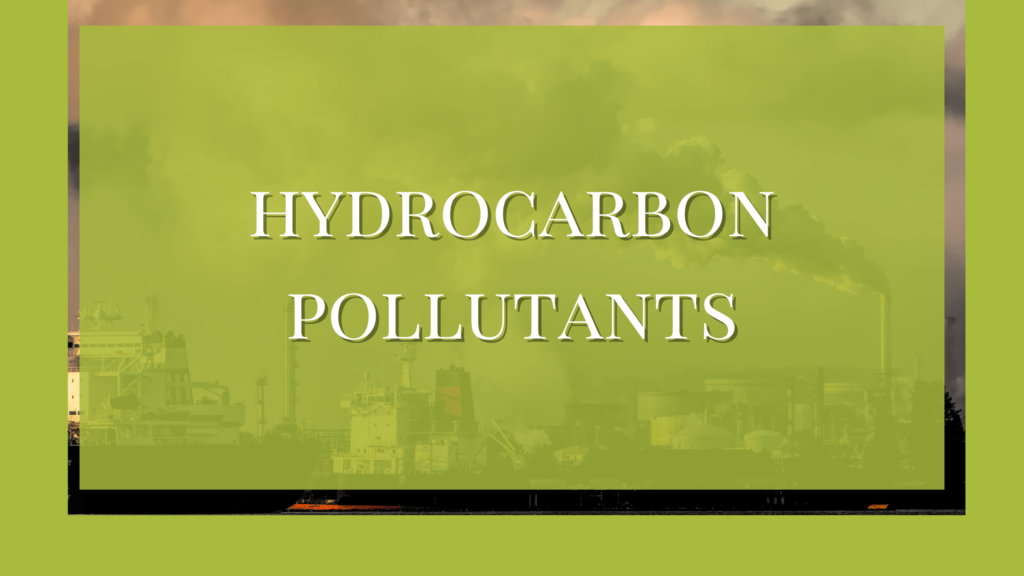Hydrocarbons are composed of hydrogen and carbon. The hydrocarbon pollutants are formed by incomplete combustion of fuel in automobiles. They are also released into the air as components of natural gas and by the evaporation of petrol as well as other organic solvents. Hydrocarbons are formed by bacterial decomposition of organic matter as well.
Effect of Hydrocarbon Pollutants
- Many hydrocarbons are carcinogenic, ie, can cause cancer.
- They harm plants by causing senescence and abscission.
- Hydrocarbon pollutants affect the microbial biome of the soil which can affect the nutrient cycles of nitrogen, phosphorus, etc. This will harm the overall plant growth.
- High concentrations of hydrocarbons in the soil are toxic to various plants.
Types of Hydrocarbon Pollutants
In the presence of sunlight, hydrocarbons react with nitrogen oxides forming harmful chemicals such as peroxyacyl nitrate, ozone aldehydes, etc.
Photochemical Oxidants
The oxides of nitrogen in the presence of sunlight react with hydrocarbons in the air to form peroxyacyl nitrate or PAN (a clear blue gas), ozone with a sharp smell, and aldehydes in the air. All kinds of phytochemicals are harmful.
PAN
It irritates the eyes and throat and produces respiratory troubles such as asthma, bronchitis, emphysema, lung cancer, etc. It can also cause harmful effects in plants, especially leafy vegetables like lettuce and spinach.
Ozone
The ozone layer in the upper atmosphere protects living organisms from the UV rays of the sun by absorbing nearly all of them. The ozone formed in the lower atmosphere by photochemical reactions as a result of human activity is harmful.
At low concentrations, ozone exposure causes chest pain, coughing, and often eye irritation. High concentrations can kill both animals and plants. Ozone toxicity of plants is manifested by markings on leaves and leads to premature yellowing and fall of leaves.
Ozone attacks textiles causing discoloration and disintegration of clothes. It damages rubber, particularly automobile tires and rubber ceilings around windows and in insulations or electric wiring.
Aldehydes
These compounds irritate gastrointestinal and respiratory tracts.
Aerosols
Aerosols are chemicals released into the air with force as vapors. These include CFC, nitrogen and sulfur oxides, polychlorinated biphenyls (PCBs), and tobacco smoke.
PCBs
PCBs are produced by burning plastic that produces polychlorinated biphenyls which are persistent and pass into the food chain. It can damage the liver and central nervous system, impair vision, and change the skin pigment.
Unsaturated Hydrocarbon Pollutants
The unsaturated hydrocarbons increase the early motivation of tissue, promote early leaf and fruit fall, etc. Hydrogen sulfide causes mottled chlorosis and defoliation in plants. It causes decolorization of paints and causes eye irritation as well as throat irritation in humans. It may also cause nausea.
Hydrocarbons are produced naturally due to incomplete combustion of marsh gas. They are carcinogenic and cause mucus membrane irritation, bronchial constriction, and tearing of the alveolus.
References
- Shukla, R.S. and Chandel, P.S. (2001) Plant Ecology. S. Chand and Company Ltd., New Delhi.
- Verma, P.S., Agarwal, V.K. (1999). Cell biology genetics molecular biology evolution and ecology. New Delhi: S.Chand Co.(Pvt) Ltd.




